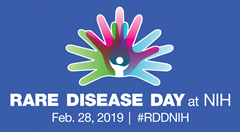 Each year on Rare Disease Day, held on the last day of February, the global rare disease community gets together to share their stories and plan activities aimed to raise awareness.
Each year on Rare Disease Day, held on the last day of February, the global rare disease community gets together to share their stories and plan activities aimed to raise awareness.
For many years, the Coriell Institute for Medical Research has been a proud member of the rare disease community. Our founder, the famed virologist Lewis L. Coriell, collaborated with the National Institute for General Medical Science’s on the creation of the Human Genetic Cell Repository, a collection of cell and DNA samples representing heritable disorders and chromosomal abnormalities, stored at our facility for use in medical research.
In the 45 years since that collection’s creation, the HGCR has become one of the most diverse collections of biospecimens in the world and offers samples from more than 1,000 rare genetic diseases, including some of the rarest diseases in the world. Samples from that collection are sent to scientists around the world studying these diseases in hopes of learning more about them — the basic understanding of them and how to better treat or even cure them.
Our relationships with members of the rare disease community made that possible. Without individuals and families willing to share their stories and their samples with us, the collection would never have been able to develop into the critical resource it’s become.
In the process, we also created something special — a direct avenue for a patient with a rare disease to contribute to the scientific effort happening all over the world. When a patient with a rare disease donates a blood or skin sample to us, they open up the possibility that it will be their specific biological sample DNA will be used in breakthroughs for their disease. This material is treasured by us in the biobank and by the scientists who obtain them, as we acknowledge the commitment it shows on the part of the patient.This work would be simply impossible without it.
A diagnosis of a rare genetic disease can be scary. Many family doctors tend to be unfamiliar with many of these diseases, leaving families already afflicted with disease symptoms to find answers on their own. This time can also give some a new purpose as they find meaning and new focus in advocacy work.
Carrie Ostrea, a leader in rare disease advocacy, first entered the world of advocacy while working to obtain a diagnosis for her daughter, Hannah. Hannah was ultimately diagnosed with Gaucher’s disease type 2 and passed just a couple of years later. She offered this advice to parents who find themselves in a similar situation:
“Balance your life. You’re going to have an overwhelming lifestyle. You’re going to become a researcher, a nurse, an appointment scheduler. You never thought you’d be these things, but you can do it,” Carrie said. “Find support through family or a rare disease foundation or families fighting a similar fight. You have to get comfortable in the spot you’re in before trying to tackle more. There’s so much to do, but you have to find balance.”
In continuing to grow the HGCR collection, Coriell hopes to better connect these two sides of rare disease research — patients and their families and scientists — to bolster the effort as a whole.
Coriell representatives, including Deborah Requesens, PhD, the principal investigator of the collection, will attend the Rare Disease Day event hosted by the National Institutes of Health in Washington D.C. on Thursday, Feb. 28. They’ll be there to meet people and to answer questions that anyone might have about biobanking and its role in research.